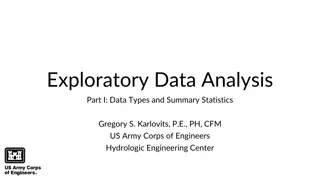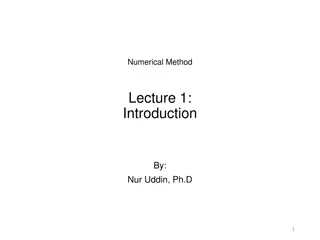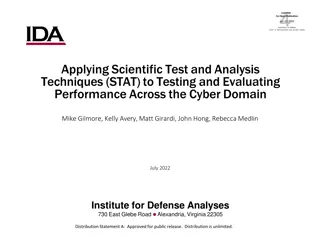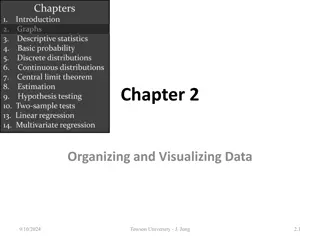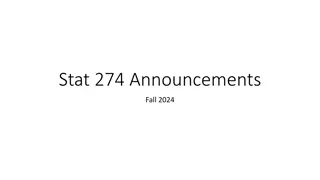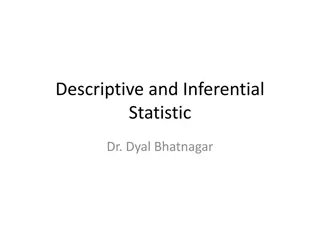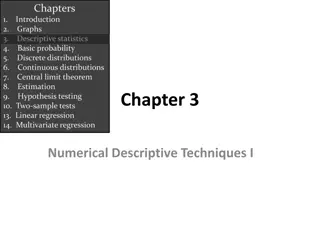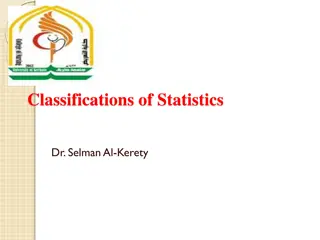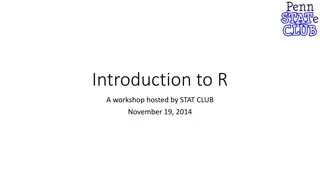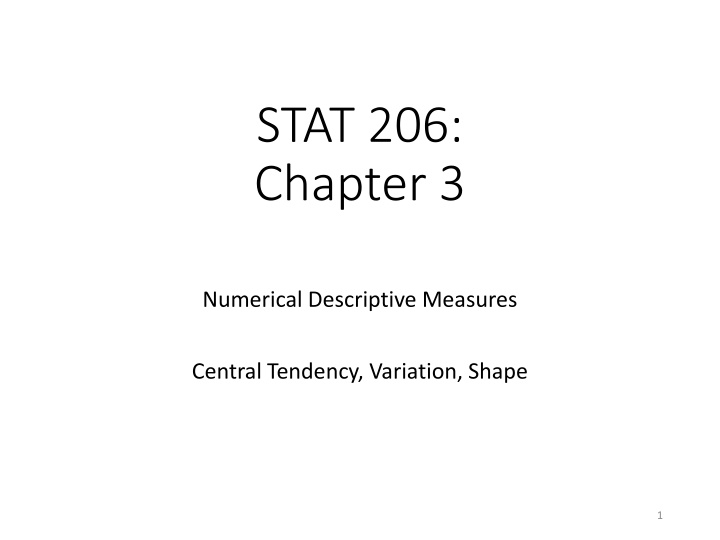
Numerical Descriptive Measures in Statistics
Explore the concept of central tendency in statistics, covering mean, median, and mode. Discover how these measures help in understanding the distribution of values in a dataset, along with their implications for data analysis and interpretation.
Download Presentation

Please find below an Image/Link to download the presentation.
The content on the website is provided AS IS for your information and personal use only. It may not be sold, licensed, or shared on other websites without obtaining consent from the author. If you encounter any issues during the download, it is possible that the publisher has removed the file from their server.
You are allowed to download the files provided on this website for personal or commercial use, subject to the condition that they are used lawfully. All files are the property of their respective owners.
The content on the website is provided AS IS for your information and personal use only. It may not be sold, licensed, or shared on other websites without obtaining consent from the author.
E N D
Presentation Transcript
STAT 206: Chapter 3 Numerical Descriptive Measures Central Tendency, Variation, Shape 1
3.1 Central Tendency Central Tendencyis extent to which values of a variable group around a typical, or central, value 3 different ways to consider the center of the distribution Balancing point (mean/average) Value divides the upper half from the lower half of the data (median) Value(s) occurs most often (mode) Let s call the variable X x (or xi ) = value for one record (x1, x2, , xn) n = number of values ?? means the sum of all of the ?? values That is, ??= x1+x2+x3+ + xn 2
MEAN arithmetic average Let s use our variable X x (or xi ) = value for one record (x1, x2, , xn) n = number of values ?( x-bar ) is the sample mean of the variable X Sample mean is the sum of values in a sample divided by the number of values in the sample: ?? ?=?1+?2+ +?? ??? ?? ?????? ?????? ?? ??????= ? = ?????? ???? = ? 3
MEAN example Example: what is the (typical) MEAN time it takes you to get ready in the morning? Measure time between when you get up until you leave your home (rounded to the nearest minute) for 10 days. Day Time 1 2 3 4 5 6 7 8 9 10 35 39 29 43 52 39 44 40 31 44 ?? ?=?1+?2+ +?? ??? ?? ?????? ?????? ?? ??????= ? = ?????? ???? = = ? 39+20+43+52+39+44+40+31+44+35 10 =396 10 = 39.6 ??????? Notice: No individual day had a value of 39.6. It is an average No very small or very large values in the data But what if there were? 4
MEAN example Consider if on day 3, it took 103 minutes. Example: what is the (typical) MEAN time it takes you to get ready in the morning? Measure time between when you get up until you leave your home (rounded to the nearest minute) for 10 days. Day Time 1 2 3 4 5 6 7 8 9 10 35 39 29 103 52 39 44 40 31 44 ?? ?=?1+?2+ +?? ??? ?? ?????? ?????? ?? ??????= ? = = ? 39+20+???+52+39+44+40+31+44+35 10 =456 10 = 45.6 ??????? ONE extreme value changed the mean by 6 minutes MEAN is STRONGLY AFFECTED by extreme values Is it still central ? 5
Median middle value MEDIAN middle value in an ordered array of data (ranked from smallest to largest) Half values are smaller than or equal to median Half values are larger than or equal to median NOT affected by extreme values MUST RANK IN ORDER ?+1 2 ranked value If n is ODD, median is the measurement/value associated with the middle-ranked value If n is EVEN, median is the measurement associated with the average of the two middle-ranked values MEDIAN = 6
MEDIAN example Example: what is the (typical) MEAN time it takes you to get ready in the morning? Measure time between when you get up until you leave your home (rounded to the nearest minute) for 10 days. Day Time 1 2 3 4 5 6 7 8 9 10 35 39 29 43 52 39 44 40 31 44 Order Values smallest to largest Values Ranks 29 1 31 35 3 39 4 39 5 40 6 43 7 44 8 44 9 52 10 2 ?+1 2 ranked value = 10+1 2 MEDIAN = use Rule 2 (for n even) MEDIAN = average of fifth and sixth ranked values = 2 = 39.5, which is VERY close to the mean value of 39.6 Consider the extreme value example = 5.5 39+40 39.5 NO change in the Median due to extreme Ranks Values 1 2 3 4 5 6 7 8 9 10 103 29 31 35 39 39 40 44 44 52 7
Median example 2 Calories for 7 breakfast cereals. Compute the median. Values Ranks 80 100 100 110 190 200 240 1 2 3 4 5 6 7 ?+1 2 ranked value = 7+1 2 MEDIAN = use Rule 1 (for n odd) MEDIAN = fourth ranked values = 110 calories = 4 Notice: Data must be ordered Maintain duplicates of data values 8
MODE most frequently occurring value Extreme values do NOT affect the MODE There may be one mode, two modes (bi-modal), three modes (tri-modal), etc. OR there may be NO mode if all values are unique EXAMPLE: times to get ready in the morning (again) Values Values 29 31 35 39 39 40 43 44 44 52 29 31 35 39 39 40 43 44 44 52 Two modes BI-modal 9
Examples: Find MEDIAN, mean and mode number of homeruns for Mark McGwire s reported seasons: n=13 and ??= 519 49 32 33 39 22 42 9 9 39 52 58 70 65 Step 1: Order the observations from smallest to largest 9 9 22 32 33 39 39 42 49 52 58 65 70 Step 2: Is the number of observations even or odd? 9 9 22 32 33 39 39 42 49 52 58 65 70 ODD n+1 = 13+1 = 14 and 14 2= 7 7th obs in ordered array Step 3: So What is the median? A. 39.92 B. 39 C. 9 and 39
Examples: Find median, mean and mode number of homeruns for Mark McGwire s reported seasons: n=13 and ???= ??? 9 9 22 32 33 39 39 42 49 52 58 65 70 ? =??? ?? ???????????? = ?? =519 13 What is the MEAN? ? ? = 39.92308 39.92 What is the MODE? TWO modes BI-modal 9 and 39
EXCEL functions for Central Tendency MEAN: =AVERAGE(<data string>) MEDIAN: =MEDIAN(<data string>) MODE: =MODE(<data string>) 12
3.2 Variation and Shape VARIATION measures the amount of dispersion, or scattering from a central value. That is, how spread out are the data values RANGE = largest value smallest value = maximum minimum = xlargest xsmallest EXAMPLE: times to get ready in the morning (and again) Values 29 31 35 39 39 40 43 44 44 52 RANGE = largest value smallest value = 52 29 = 23 minutes 13
VARIANCE ( VARIANCE (?2) and STANDARD DEVIATION, ( ) and STANDARD DEVIATION, (?) ) VARIANCE: average of the squared deviations of each observation from the mean ?2= (? ?)2 (? 1) Variance is difficult to interpret. STANDARD DEVIATION: square root of the variance 2 ( ) x = 2 x (? ?)2 (? 1) n or s ?2= ? = 1 n Can be thought of as a typical / average distance of an observation from the mean REMEMBER! Neither the variance nor the standard deviation can ever be NEGATIVE
EXCEL functions for Variation VARIANCE: =VAR.S(<data string>) =VAR.P(<data string>) sample population STANDARD DEVIATION: =STDEV.S(<data string>) =STDEV.P(<data string>) sample population 15
Example Example: Scores for CLASS A: 30, 65, 70, 76, 93, 99 Scores for CLASS B: 68, 72, 73, 73, 74, 77 n 6 6 Mean 72.17 72.83 Median 73 73 Class A Class B What is the difference? Find the standard deviation for each class. n = 6 = Class A x- ? -42.17 1778.31 -7.17 -2.17 3.83 20.83 2 ( X ) x 2 s (x- ?)2 X 30 65 70 76 x-xbar (x-xbar)2 x-xbar (x-xbar)2 -42.17 -7.17 -2.17 3.83 20.83 26.83 26.83 26.83 x x X 30 65 70 76 93 99 99 Variance = x-xbar (x-xbar)2 -42.17 -7.17 -2.17 3.83 20.83 1 n 30 65 70 76 93 99 99 30 65 70 76 93 93 1778.03 51.36 4.69 14.69 434.03 720.03 720.03 3002 . 83 = = 51.41 4.69 14.69 434.03 600 57 . 5 = var iance Standard deviation = = 24 51 . 600 57 . 0.00 3002.83 Always 0 except for rounding For Class B, s=2.93. Verify on your own as practice.
Standard deviation, or s, controls the spread. That is, the larger the value of s, the more spread out or variable the data are.
Z scores Z scores Z-score is equal to the difference between a value and the mean, divided by the standard deviation ? ? ? ? = Z is a UNIT OF MEASURE of the number of standard deviations If positive, ABOVE the mean If negative, BELOW the mean Z helps identify outliers In general, Z < -3.00 or Z > 3.00 indicates an outlier value EXAMPLE: times to get ready in the morning (and again) ? = 39.6 and s = 6.77. What is the Z-score for 39 minutes to get ready? ? ? ? = 6.77 39 39.6 = 0.60 6.77= 0.09 ? =
Shape Shape of a variable pattern of distribution of values from the lowest value to the highest value SKEWNESS: extent to which data values are not symmetrical around the mean e.g., human height human weight, bone length, etc. IQ scores Symmetric if the right and left sides of the histogram are approximately mirror images of each other Skewed to the right if the right tail extends much farther out than the left tail Skewed to the left if the left tail extends much farther out than the right tail e.g., income data survival data e.g., test grades, possibly birth weight (in certain populations) e.g., roll of a fair die (or dice), coin toss e.g., restaurant peak times (noon, 7:00pm) Uniform if all bars are the same height Bimodal if two (2) bars are higher than others
patte rn of distri butio n of value s from Examples: mean The mean is strongly influenced by a few extreme observations The median is not strongly influenced by a few extreme observations If the distribution is symmetric mean the lowes t value to the highe st value mean vs. median vs. median median Mean Median skewed right mean median Mean > Median skewed left mean median Mean < Median
3.3 Exploring Numerical Data Let s consider Measures of Position: PERCENTILES, QUARTILES, and 5-NUMBER SUMMARY PERCENTILE: the pth percentile is a value such that p percent of the observations fall below (or at) that value QUARTILES: special cases of percentiles Q1 = observation at the 25th percentile ( (?+1) Q2 = observation at the 50th percentile (median of entire data set) Q3 = observation at the 75th percentile ( 3(?+1) ranked value) 4 ranked value) 4 5-NUMBER SUMMARY includes: minimum, Q1, Q2 (median), Q3, maximum 21
Restaurant Type Calories Example Example: Use the table (at the right) to find the 5-number summaries for calories in hamburgers for each of the three restaurants. (source: www.acoloriecounter.com/fast-food.php ). Burger King: 13 obs median = (13+1) - min=370 1 2 3 4 5 6 7 8 9 10 Burger King Double Whopper (cheese) 11 Burger King Quad Stacker 12 Burger King Triple Whopper 13 Burger King Triple Whopper (cheese) Burger King Whopper Jr. Burger King Whopper Jr. (cheese) Burger King Double Hamburger Burger King Double Cheeseburger Burger King Double Stacker Burger King Whopper Burger King Whopper (cheese) Burger King Triple Stacker Burger King Double Whopper 370 410 410 500 610 670 760 800 900 990 1000 1130 1230 Q1=455 - Median=760 Q3=995 = 7th obs - max=1230 2 Q1 = (13+1) Q1=(410+500)/2=455 = 3.5 (avg 3rd & 4th) 1 2 3 4 5 6 7 8 9 10 Hardee's 11 Hardee's 12 Hardee's Hardee's Hardee's Hardee's Hardee's Hardee's Hardee's Hardee's Hardee's Hardee's Low Carb Thickburger Double Hamburger Double Cheeseburger Cheeseburger Mushroom N' Swiss Thickburger Thickburger Bacon Cheese Thickburger Grilled Sourdough Thickburger Six Dollar Burger Double Thickburger Double Bacon Cheese Thickburger Monster Thickburger 420 420 510 680 720 910 910 1030 1060 1250 1300 1420 4 Q3 = 3(13+1) Q3=(410+500)/2=455 = 10.5 (avg 10th & 11th) 4 BK 5-number summary 370, 455, 760, 995, 1230 McDonald s 5-number summary 440, 460, 510, 540, 740 - min=440 - Q1=460 1 McDonald's Double Cheeseburger 440 2 3 McDonald's Big N' Tasty McDonald's Quarter Pounder (cheese) 460 510 Median=510 - Q3=540 Hardee s 5-number summary Complete on your own 4 5 6 McDonald's Big N' Tasty (cheese) McDonald's Big Mac McDonald's Double Quarter Pounder (cheese) 510 540 740 - max=740
EXCEL functions for 5-Number Summary Minimum: =MIN(<data string>) Quartile 1 (Q1): =QUARTILE.EXC(<data string>,1) Quartile 2 (Q2) or Median =MEDIAN(<data string>) Quartile 3 (Q3): =QUARTILE.EXC(<data string>,3) Maximum: =MAX(<data string>) 23
Use 5-Number summaries to construct boxplots. To compare different groups (e.g., restaurants), side-by-side boxplots can be constructed. (We will use Burger King s to identify the boxplot features with the 5-number summary.) Calories Max=1230 Q3=995 Median=760 Q1=455 Min=370 BK 5-number summary 370, 455, 760, 995, 1230 Fast Food Restaurant
Calories Which restaurant has higher calories overall? Hardee s Which restaurant has the least variability in calories? McDonald s Fast Food Restaurant
Distribution Shape and The Boxplot Left-Skewed Symmetric Right-Skewed Q1Q2Q3 Q1 Q2Q3 Q1Q2Q3 Pearson slide (Chapter 3, #50)
3.4 Numerical Descriptive Measures for a Population 3.1 and 3.2 discuss statistics for a SAMPLE When data are collected for an entire population, analyze populationPARAMETERS POPULATION mean (?) is the sum of values in a POPULATION divided by the number of values in the POPULATION: ??? ?? ?????? ?????? ?? ??????= ?? ?=?1+?2+ +?? ? = ? 27
Population Variance and Standard Deviation POPULATION variance (??) is the average of the squared deviations of each observation from the POPULATION mean: ?2= (? ?)2 ? POPULATION standard deviation (?) is the square root of the POPULATION variance, ?2: (? ?)2 ? = ? 28
Sample statistics versus population parameters Measure Population Parameter Sample Statistic Mean X Variance 2 2 S Standard Deviation S Pearson slide (Chapter 3, #56)
Empirical Rule for normal distributions Remembering that in many data sets, a large portion of the values tend to cluster somewhere near the mean For normal (bell-shaped, symmetric) distributions, we are able to use the Empirical Rule Within 1 std dev of the mean (gray area) ~ 68% Within 2 std dev of the mean (gray + yellow) ~ 95% Within 3 std dev of the mean (gray + yellow + orange) ~ 99.7%
Example: The Health and Nutrition Examination Study of 1976-1980 (HANES) studied the heights of adults (aged 18-24) and found that the heights follow a normal distribution with the following: Women Mean ( ): 65.0 inches standard deviation ( ): 2.5 inches Men Mean ( ): 70.0 inches standard deviation ( ): 2.8 inches Find the proportion of men with heights between 67.2 inches and 72.8 inches. Proportion of men with heights are between 67.2 ( - ) inches and 72.8 ( + ) inches is 0.68 (68%) per the Empirical Rule. 0.68 61.6 64.4 67.2 70 72.8 75.6 78.4
Questions: If your data distribution follows a normal distribution, what proportion of the data do we expect to find below the mean? A. 0.997 (99.7%) B. 0.95 (95%) C. 0.68 (68%) D. 0.50 (50%) Math SAT scores follow a normal distribution with a mean of 500 and standard deviation of 100. Calculate the standard score for a score of 630. A. 1.3 B. 1.1 C. -1.3 D. -1.1 = 130 100 = 1.3 z = ? ? ? = 630 500 100 32
Questions: Two students get a 65 on different tests. Student A has a standard score of -1 while Student B has a standard score of -2. Which student had the better performance on the test? A. Student A B. Student B C. Both students gave equal performances. A B
Chebyshev Rule Can t use the Empirical Rule for heavily skewed data sets Chebyshev rule states that for any data set, regardless of shape, the percentage of values found within k standard deviations of the mean must be at least: % (within k std dev) = 1 1 ?2 100% % of Data Values Around the Mean Chebyshev (any distribution) (? ? , ? + ?) at least 0% Empirical (normal) ~ 68% Interval 1 12= 1 1 = 0) (1 1 22= 1 1 (1 4= 0.75) (? 2? ,? + 2?) at least 75% ~ 95% 1 32= 1 1 (1 9= 0.8889 (? 3? ,? + 3?) at least 88.89% ~ 99.7% 34
Example: A population of 2-liter bottles of cola is known to have a mean fill-weight of 2.06 liter and a standard deviation of 0.02 liter. However, the shape of the population is unknown, and you cannot assume that it is bell-shaped. Describe the distribution of fill-weights. (? ? , ? + ?) = 2.06 0.02 = (2.04 , 2.08) (? 2? ,? + 2?) = 2.06 2(0.02) = (2.02 , 2.10) (? 3? ,? + 3?) = 2.06 3(0.02) = (2.00 , 2.12) 0% 75% 88.89% Is it very likely that a bottle will contain less than 2 liters of cola? Between 0% and 11.11% of the bottles will contain less than 2 liters 35
Review: Empirical Rule: Within 1 std dev of the mean (gray area) ~ 68% Within 2 std dev of the mean (gray + yellow) ~ 95% Within 3 std dev of the mean (gray + yellow + orange) ~ 99.7% 1 Chebyshev s Rule: at least % (within k std dev) = 1 ?2 100% 36
Questions: If your data contain an extreme value on the high side, what is the impact on the MEAN of your data set? A. ? is pulled in the opposite direction of the extreme value B. There is little (no) impact on the value of ? C. ? is pulled in the direction of the extreme value If your data contain an extreme value on the high side, what is the impact on the MEDIAN of your data set? A. Median is pulled in the opposite direction of the extreme value B. There is little (no) impact on the value of median C. Median is pulled in the direction of the extreme value 37
Review: Evaluation of data involves Central Tendency, Variation, Shape Sample mean is the sum of values in a sample divided by the number of values in the sample: ? = ?????? ?? ??????= MEAN is STRONGLY affected by extreme values MEDIAN: middle value in an ordered array of data NOT strongly affected by extreme values MODE: most frequently occurring value NOT strongly affected by extreme values May be used for categorical or numerical data May be no mode, one mode, two modes, VARIABILITY: how spread out the data are RANGE: maximum minimum VARIANCE: STANDARD DEVIATION: ? = ?? ?=?1+?2+ +?? ??? ?? ?????? ? ?2= (? ?)2 (? 1) (? ?)2 (? 1) ?2= Typical / average distance of an observation from the mean CANNOT be negative larger the value of s, the more spread out or variable the data are 38
Questions: Which of the following graphics shows data with the lowest standard deviation? A. B. C. Pictured at the right are two different normal distributions. What is different between the two distributions? A. Mean B. Standard deviation C. Both 39
Review: VARIANCE: STANDARD DEVIATION: Typical / average distance of an observation from the mean Z-scores: Z is a UNIT OF MEASURE of the number of standard deviations In general, Z < -3.00 or Z > 3.00 indicates an outlier value Skewness: Symmetric if right and left sides of histogram are mirror images Skewed to the right if right tail extends much farther (high extremes) Skewed to the left if left tail extends much farther (low extremes) QUARTILES: divide data into four parts Q1 = observation at the 25th percentile (median of lower half of data set) Q2 = observation at the 50th percentile (median of entire data set) Q3 = observation at the 75th percentile (median of upper half of data set) 5-Number Summary: min, Q1, median, Q3, max (visualize with BOXPLOT) ?2= (? ?)2 (? 1) (? ?)2 (? 1) ?2= ? = ? ? ? ? = 40



